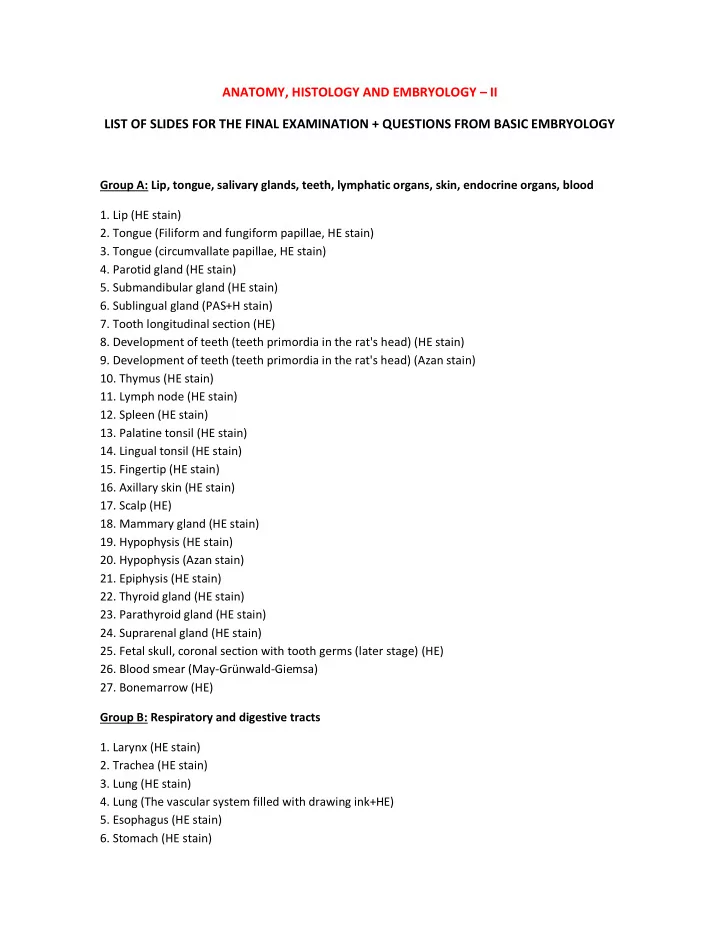

ANATOMY, HISTOLOGY AND EMBRYOLOGY – II LIST OF SLIDES FOR THE FINAL EXAMINATION + QUESTIONS FROM BASIC EMBRYOLOGY Group A: Lip, tongue, salivary glands, teeth, lymphatic organs, skin, endocrine organs, blood 1. Lip (HE stain) 2. Tongue (Filiform and fungiform papillae, HE stain) 3. Tongue (circumvallate papillae, HE stain) 4. Parotid gland (HE stain) 5. Submandibular gland (HE stain) 6. Sublingual gland (PAS+H stain) 7. Tooth longitudinal section (HE) 8. Development of teeth (teeth primordia in the rat's head) (HE stain) 9. Development of teeth (teeth primordia in the rat's head) (Azan stain) 10. Thymus (HE stain) 11. Lymph node (HE stain) 12. Spleen (HE stain) 13. Palatine tonsil (HE stain) 14. Lingual tonsil (HE stain) 15. Fingertip (HE stain) 16. Axillary skin (HE stain) 17. Scalp (HE) 18. Mammary gland (HE stain) 19. Hypophysis (HE stain) 20. Hypophysis (Azan stain) 21. Epiphysis (HE stain) 22. Thyroid gland (HE stain) 23. Parathyroid gland (HE stain) 24. Suprarenal gland (HE stain) 25. Fetal skull, coronal section with tooth germs (later stage) (HE) 26. Blood smear (May-Gr ünwald -Giemsa) 27. Bonemarrow (HE) Group B: Respiratory and digestive tracts 1. Larynx (HE stain) 2. Trachea (HE stain) 3. Lung (HE stain) 4. Lung (The vascular system filled with drawing ink+HE) 5. Esophagus (HE stain) 6. Stomach (HE stain)
7. Stomach (PAS+H stain) 8. Gastro-duodenal junction (HE stain) 9. Gastro-duodenal junction (PAS+H stain) 10. Jejunum (HE stain) 11. Ileum (jejunum) (Goldner's stain) 12. Colon (HE stain) 13. Appendix (HE stain) 14. Rectum (HE stain) 15. Pancreas (HE stain) 16. Liver from pig (HE stain) 17. Liver from pig (Azan stain) 18. Human liver (HE stain) 19. Liver from rat (Trypan blue vital stain + Nuclear fast red stain) 20. Gall bladder (HE) Group C: Urogenital system 1. Kidney - coronal section (HE stain) 2. Kidney - tangential section (HE stain) 3. Ureter (HE stain) 4. Urinary bladder (HE stain) 5. Urethra masculina (HE stain) 6. Cross section of an embryonic penis (HE stain) 7. Testis and epididymis (HE stain) 8. Spermatic cord (HE stain) 9. Seminal vesicle (HE stain) 10. Prostate (HE stain) 11. Vagina (HE stain) 12. Ovary (HE stain) 13. Ovary with corpus luteum (HE stain) 14. Uterine tube (HE stain) 15. Uterus - proliferative stage (HE stain) 16. Uterus - secretory stage (HE stain) 17. Pregnant uterus (HE stain) 18. Placenta (HE stain) Basic Embryology 1. Primordial germ cells. Mitosis and meiosis. Development of gonads. 2. Maturation of gametes: oogenesis. Body cavities in the early phase of embryonic development: blastocyst cavity, amnion, chorionic cavity, primitive and definitive yolk sac. 3. Maturation of gametes: spermatogenesis and spermiogenesis. Migration of primordial germ cells and its role in the development of gonads
4. Cellular and hormonal background of menstrual cycle. 5. Fertilization. 6. Segmentation. Formation of blastocyst. Implantation. Major characteristics of embryonic and adult stem cells. 7. Formation and early differentiation of embryoblasts and trophoblasts. Teratogenicity. 8. Formation and derivatives of extraembryonic mesoderm. Early steps of placentation. 9. Gastrulation, the formation of the trilaminar germ disc. Formation of notochord. 10. Differentiation of ectoderm and its derivatives. Neurulation. 11. Differentiation of ectoderm and its derivatives. Neural crest and its derivatives. Definition and significance in development of epithelo-mesenchymal and mesenchymal-epithelial transitions. 12. Differentiation of ectoderm and its derivatives. Placods and its derivatives. Ectomesenchyme. 13. Differentiation and derivatives of intraembryonic mesoderm. Paraxial mesoderm. 14. Differentiation and derivatives of intraembryonic mesoderm. Intermediate and lateral plate mesoderm. Early steps of the formation of intraembryonic body cavities. 15. Differentiation and derivatives of the endoderm. 16. Definition of organogenesis. Cephalo-caudal and lateral folding of the embryo. 17. Foetal development (changes of the external features). External features of the mature foetus (newborn). 18. Foetal membranes, amniotic fluid. Lanugo fetalis, vernix caseosa. Twin pregnancy. 19. Hemopoiesis before and after birth. Erythropoiesis. Formation of megakaryocytes. Thrombopoiesis. 20. Granulopoiesis. Monopoiesis. Lymphopoiesis. Development of thymus. 21. Development of teeth. Dentition. 22. Development of kidneys, formation of uropoietic (urine producing) elements. 23. Development of muscular system and smooth muscle tissue of internal organs. 24. Development of skin, formation of skin appendages, including mammary gland. 25. Development and maturation of lung tissue. Respiratory distress syndrome.
Recommend
More recommend